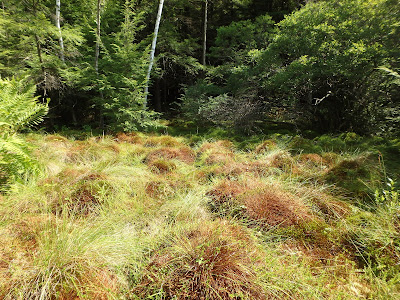2016 Catch Up, July and August
July 2016 Plants
Over the last 4 years during the month of July I have spent time
in central Pennsylvania working on an invasive plant survey within Sproul,
Tuscarora, Rothrock and Bald Eagle State forests. When I am conducting the
invasive plant survey in central PA, I always try and visit as many natural
areas as possible after work. During a visit to a new
natural area I visited last year, I was able to finally see buckbean (Menyanthes trifoliate).
 |
| Buckbean (Menyanthes trifoliate) |
Though not a
listed plant species here in PA, still a very cool plant to see in the field. Menyanthes is a monotypic genus usually found growing
in areas associated with acidic water and sphagnum moss. I came across this
very large population of buckbean within a cranberry bog in Sproul State
Forest. Buckbean is a very easy plant to identify in the field as one can see by
its obvious 3 lobed compound leaf which kind of have a thick and leather-like
texture. Only thing that was disappointing about this experience was the lack
of flowers. Buckbean has a very
interesting distribution within the US, where it is common in the far
northeast, upper great lakes region and northwest, though rare throughout the
northern Midwest states.
Another plant that I enjoy seeing during my time in Sproul
State Forest is the brownish beaksedge (Rhynchospora
capitellata).
 |
| Brownish beaksedge (Rhynchospora capitellata) |
Though not a rare plant in PA, the brownish beaksedge may be a
plant that some of us may not see that often. Belonging to the cyperaceae plant
family, brownish beaksedge has very unique dark brownish colored
spikelets that are almost impossible to overlook. When in the field Rhynchospore can be quickly separated
from Carex by the presence of
bisexual flowers that lack a perigynium enclosing the achene.
I certainly love spending time botanizing in central PA, who
can resist the beautiful rolling mountains and deep river valleys.
 |
| West Branch of the Susquehanna |
Only thing
that makes me nervous is the threat of timber rattlesnakes, especially when I
spend so much time kneeling on the ground looking at plants.
 |
| Brown phase timber rattlesnake |
Doesn’t matter if
you are walking through upland rocky rights of ways or bogs, in Sproul State
forest you can usually find a timber rattlesnake anywhere.
August 2016 Plants
In 2016, I think I have finally come across the coolest
looking sedge to date for me. While exploring a bog within Tioga County PA, I
came across the unique bog sedge (Carex
magellanica subsp. irrigua).
 |
| Bog sedge |
Can’t beat the excitement a plant geek feels the moment you finally step into
an open bog community after trekking through a shaded upland forest for 30
minutes, it’s just such an abrupt from one plant community to another.
 |
| Tioga County PA Bog |
During the middle of August 2016 I found myself doing
wetland and stream work on a famous Pittsburgh island called Brunot Island. The
island is within the Ohio River just west of the city.
 |
| Northwest Bank of Brunot Island looking upstream on the Ohio River |
My understanding is that
the Brunot family owned and lived on the island during the 1700 and 1800’s and
somehow the Lewis and Clark expedition spent the night on the island in the
summer of 1803. Presently the island is home to a large power generating
station and very disturbed environmentally. Lots of slag and invasive plants
dominate the island.
 |
| View inland on Brunot Island |
Still, I was able to find some pretty cool plants while
walking the island in search of wetlands. Though not rare by any means here in
PA, some cool plants observed on Brunot Island were blue-curls (Trichostema dichotomum) and freshwater
chordgrass (Spartina pectinata).
 |
| blue-curls (Trichostema dichotomum) |
 |
| freshwater chordgrass (Spartina pectinata) |
Late August I was in Guilford County North Carolina conducting
stream and wetlands surveys. While in North Carolina I was able to observe 2
plant species I have been anxious to see for quite some time. The first plant I
finally got to see in the field was gamma grass (Tripsacum dactyloides).
 |
| gamma grass (Tripsacum dactyloides) |
Gamma grass is a very large and unique
grass closely related to corn. Not the best photo I have taken, but in the
picture above you can still make out the male flowers positioned at the top of the
spike while the female flowers can be observed below. Currently in PA the state
status for gamma grass is undetermined yet proposed endangered. I was observing
gamma grass growing in many of the transmission line right of ways while in
North Carolina mainly in dry to mesic environments.
The second plant I got to observe while in North Carolina was
upright primrose willow (Ludwigia decurrens).
 |
| upright primrose willow (Ludwigia decurrens) |
At first site this plant was easy to recognize that it beloged to the
onagraceae family by the 4 yellow petal flowers and simple leaves.
 |
| upright primrose willow flower |
The most
unique feature of this Ludwigia was
the presence of the ‘winged’ stem.
 |
| Upright primrose willow 'winged' stem, look close |
Here in PA upright primrose willow is listed as endangered. I have never come across this plant in PA but observed it growing in many fringe wetlands along perennial streams in North Carolina.






















